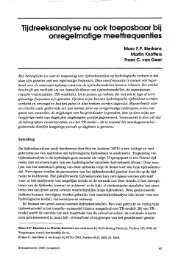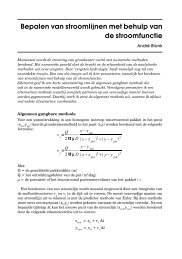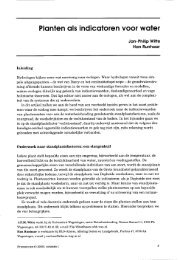PDF Viewing archiving 300 dpi - NHV.nu
PDF Viewing archiving 300 dpi - NHV.nu
PDF Viewing archiving 300 dpi - NHV.nu
Create successful ePaper yourself
Turn your PDF publications into a flip-book with our unique Google optimized e-Paper software.
ORIGIN OF PRECIPITATION<br />
F.H. SCHMIDT<br />
Royal Netherlands Meteorological Institute, De Bilt<br />
In Western Europe, precipitation is normal phenomenon; it is of importance to<br />
all aspects of society, particularly to agriculture, in cattle breeding and, of course, it is a<br />
subject of hydrological research. Precipitation is an essential part in the hydrological<br />
---,-- --- - *-<br />
a&. How disastrous local conditions may be when precipitation holds off was obvious<br />
recently in the Sahel territory, where for several years precipitation, which had previously<br />
been marginal, stayed well under normally expected quantities. This introductory paper<br />
aims at conclusions that may be drawn with respect to the distribution of rainfall, when<br />
judged from a scrutiny of the mechanism that is responsible for the very origin of precipitation.<br />
(See Fletcher (1 962) and Mason (197 1)).<br />
Precipitation is exclusively caused by clouds, and the origin of clouds is in itself some-<br />
thing special. The condensation of water vapour, which results into clouds, cannot take<br />
w-rV=.% P<br />
place in pure air. For, -- relative humidities of <strong>300</strong> to 40W0 would then be necessary and<br />
-"*-+-.- --<br />
such --...high .-. "L-e humiditiesnc~r<br />
- -,"- occurin the-atmosphere. That is why condensation of water<br />
vapour in the free atmosphere always takes place on small particles, the so-called condensation<br />
<strong>nu</strong>clei. These condensation <strong>nu</strong>clei can have different dimensions, generally in the<br />
order of l(rl to lop. It is interesting to note that larger condensation <strong>nu</strong>clei generally<br />
lead to larger cloud-drops.<br />
Condensation of water vapour generally takes place in the form of<br />
these drops have temperatures below zero degrees centigrade, ice-crystals may be formed.<br />
Generally speaking, in the free atmosphere this does not happen immediately at a temperature<br />
of 0°C but as a rule at lower temperatures. Even at temperatures down to -10 or<br />
-20"~ or, in extreme cases, even -40°C, waterdrops can still exist as such. They are<br />
called super-cooled droplets. .-<br />
For the forming of ice-crystals it is generally that small crystalline particles are present<br />
in the waterdrops; around these crystalline particles, the waterdrops start freezing. So<br />
there are clouds consisting of waterdrops only. There are also clouds at higher levels that<br />
exclusively consist of ice-crystals. Very important for the genesis of precipitation are<br />
those clouds that largely consist of waterdrops but in which ice-crystals are present too.<br />
also peculiar. For there are clouds that do not give precipitation and others that do. This<br />
means that apparently something special must be the matter with a cloud, should it<br />
discharge in terms of rain, hail, or snow.
















